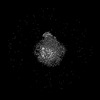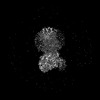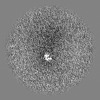[English] 日本語
 Yorodumi
Yorodumi- EMDB-37686: Cryo-EM structure of SUCR1 in complex with succinate and Gi protein -
+ Open data
Open data
- Basic information
Basic information
| Entry | 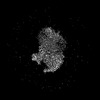 | |||||||||
|---|---|---|---|---|---|---|---|---|---|---|
| Title | Cryo-EM structure of SUCR1 in complex with succinate and Gi protein | |||||||||
 Map data Map data | ||||||||||
 Sample Sample |
| |||||||||
 Keywords Keywords | GPCR / Succinate Receptor 1 / MEMBRANE PROTEIN | |||||||||
| Function / homology |  Function and homology information Function and homology informationregulation of angiotensin metabolic process / renin secretion into blood stream / positive regulation of chemotaxis / macrophage activation involved in immune response / Class A/1 (Rhodopsin-like receptors) / Adenylate cyclase inhibitory pathway / positive regulation of protein localization to cell cortex / T cell migration / D2 dopamine receptor binding / energy homeostasis ...regulation of angiotensin metabolic process / renin secretion into blood stream / positive regulation of chemotaxis / macrophage activation involved in immune response / Class A/1 (Rhodopsin-like receptors) / Adenylate cyclase inhibitory pathway / positive regulation of protein localization to cell cortex / T cell migration / D2 dopamine receptor binding / energy homeostasis / response to prostaglandin E / G protein-coupled serotonin receptor binding / adenylate cyclase regulator activity / adenylate cyclase-inhibiting serotonin receptor signaling pathway / cellular response to forskolin / regulation of mitotic spindle organization / Regulation of insulin secretion / centriolar satellite / positive regulation of cholesterol biosynthetic process / G protein-coupled receptor binding / adenylate cyclase-inhibiting G protein-coupled receptor signaling pathway / G protein-coupled receptor activity / adenylate cyclase-modulating G protein-coupled receptor signaling pathway / G-protein beta/gamma-subunit complex binding / response to peptide hormone / Olfactory Signaling Pathway / Activation of the phototransduction cascade / G beta:gamma signalling through PLC beta / Presynaptic function of Kainate receptors / Thromboxane signalling through TP receptor / G protein-coupled acetylcholine receptor signaling pathway / response to calcium ion / G-protein activation / Activation of G protein gated Potassium channels / Inhibition of voltage gated Ca2+ channels via Gbeta/gamma subunits / Prostacyclin signalling through prostacyclin receptor / G beta:gamma signalling through CDC42 / Glucagon signaling in metabolic regulation / positive regulation of inflammatory response / G beta:gamma signalling through BTK / Synthesis, secretion, and inactivation of Glucagon-like Peptide-1 (GLP-1) / ADP signalling through P2Y purinoceptor 12 / Sensory perception of sweet, bitter, and umami (glutamate) taste / photoreceptor disc membrane / Glucagon-type ligand receptors / Adrenaline,noradrenaline inhibits insulin secretion / Vasopressin regulates renal water homeostasis via Aquaporins / G alpha (z) signalling events / GDP binding / Glucagon-like Peptide-1 (GLP1) regulates insulin secretion / ADORA2B mediated anti-inflammatory cytokines production / cellular response to catecholamine stimulus / ADP signalling through P2Y purinoceptor 1 / G beta:gamma signalling through PI3Kgamma / adenylate cyclase-activating dopamine receptor signaling pathway / Cooperation of PDCL (PhLP1) and TRiC/CCT in G-protein beta folding / GPER1 signaling / Inactivation, recovery and regulation of the phototransduction cascade / cellular response to prostaglandin E stimulus / G-protein beta-subunit binding / heterotrimeric G-protein complex / glucose homeostasis / G alpha (12/13) signalling events / sensory perception of taste / extracellular vesicle / signaling receptor complex adaptor activity / signaling receptor activity / Thrombin signalling through proteinase activated receptors (PARs) / G protein activity / GTPase binding / Ca2+ pathway / retina development in camera-type eye / midbody / cell cortex / High laminar flow shear stress activates signaling by PIEZO1 and PECAM1:CDH5:KDR in endothelial cells / fibroblast proliferation / G alpha (i) signalling events / Hydrolases; Acting on acid anhydrides; Acting on GTP to facilitate cellular and subcellular movement / G alpha (s) signalling events / phospholipase C-activating G protein-coupled receptor signaling pathway / G alpha (q) signalling events / ciliary basal body / Ras protein signal transduction / Extra-nuclear estrogen signaling / cell population proliferation / G protein-coupled receptor signaling pathway / lysosomal membrane / cell division / GTPase activity / synapse / centrosome / protein-containing complex binding / GTP binding / nucleolus / magnesium ion binding / Golgi apparatus / signal transduction / extracellular exosome / nucleoplasm / membrane Similarity search - Function | |||||||||
| Biological species |  Homo sapiens (human) Homo sapiens (human) | |||||||||
| Method | single particle reconstruction / cryo EM / Resolution: 2.97 Å | |||||||||
 Authors Authors | Liu A / Ye RD | |||||||||
| Funding support | 1 items
| |||||||||
 Citation Citation |  Journal: Cell Rep / Year: 2024 Journal: Cell Rep / Year: 2024Title: Structural insights into ligand recognition and activation of the succinate receptor SUCNR1. Authors: Aijun Liu / Yezhou Liu / Weijia Zhang / Richard D Ye /  Abstract: Succinate, a citric acid cycle intermediate, serves important functions in energy homeostasis and metabolic regulation. Extracellular succinate acts as a stress signal through succinate receptor ...Succinate, a citric acid cycle intermediate, serves important functions in energy homeostasis and metabolic regulation. Extracellular succinate acts as a stress signal through succinate receptor (SUCNR1), a class A G protein-coupled receptor. Research on succinate signaling is hampered by the lack of high-resolution structures of the agonist-bound receptor. We present cryoelectron microscopy (cryo-EM) structures of SUCNR1-Gi complexes bound to succinate and its non-metabolite derivative cis-epoxysuccinate. Key determinants for the recognition of succinate in cis conformation include R281 and Y83, while Y30 and R99 participate in the binding of both succinate and cis-epoxysuccinate. Extracellular loop 2, through F175 in its β-hairpin, forms a hydrogen bond with succinate and caps the binding pocket. At the receptor-Gi interface, agonist binding induces the rearrangement of a hydrophobic network on transmembrane (TM)5 and TM6, leading to TM signaling through TM3 and TM7. These findings extend our understanding of succinate recognition by SUCNR1, aiding the development of therapeutics for the succinate receptor. | |||||||||
| History |
|
- Structure visualization
Structure visualization
| Supplemental images |
|---|
- Downloads & links
Downloads & links
-EMDB archive
| Map data |  emd_37686.map.gz emd_37686.map.gz | 117.9 MB |  EMDB map data format EMDB map data format | |
|---|---|---|---|---|
| Header (meta data) |  emd-37686-v30.xml emd-37686-v30.xml emd-37686.xml emd-37686.xml | 17.5 KB 17.5 KB | Display Display |  EMDB header EMDB header |
| Images |  emd_37686.png emd_37686.png | 64.3 KB | ||
| Filedesc metadata |  emd-37686.cif.gz emd-37686.cif.gz | 5.9 KB | ||
| Others |  emd_37686_half_map_1.map.gz emd_37686_half_map_1.map.gz emd_37686_half_map_2.map.gz emd_37686_half_map_2.map.gz | 116 MB 116 MB | ||
| Archive directory |  http://ftp.pdbj.org/pub/emdb/structures/EMD-37686 http://ftp.pdbj.org/pub/emdb/structures/EMD-37686 ftp://ftp.pdbj.org/pub/emdb/structures/EMD-37686 ftp://ftp.pdbj.org/pub/emdb/structures/EMD-37686 | HTTPS FTP |
-Validation report
| Summary document |  emd_37686_validation.pdf.gz emd_37686_validation.pdf.gz | 975.1 KB | Display |  EMDB validaton report EMDB validaton report |
|---|---|---|---|---|
| Full document |  emd_37686_full_validation.pdf.gz emd_37686_full_validation.pdf.gz | 974.6 KB | Display | |
| Data in XML |  emd_37686_validation.xml.gz emd_37686_validation.xml.gz | 14 KB | Display | |
| Data in CIF |  emd_37686_validation.cif.gz emd_37686_validation.cif.gz | 16.5 KB | Display | |
| Arichive directory |  https://ftp.pdbj.org/pub/emdb/validation_reports/EMD-37686 https://ftp.pdbj.org/pub/emdb/validation_reports/EMD-37686 ftp://ftp.pdbj.org/pub/emdb/validation_reports/EMD-37686 ftp://ftp.pdbj.org/pub/emdb/validation_reports/EMD-37686 | HTTPS FTP |
-Related structure data
| Related structure data | 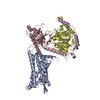 8wogMC 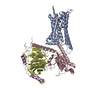 8wp1C M: atomic model generated by this map C: citing same article ( |
|---|---|
| Similar structure data | Similarity search - Function & homology  F&H Search F&H Search |
- Links
Links
| EMDB pages |  EMDB (EBI/PDBe) / EMDB (EBI/PDBe) /  EMDataResource EMDataResource |
|---|---|
| Related items in Molecule of the Month |
- Map
Map
| File |  Download / File: emd_37686.map.gz / Format: CCP4 / Size: 125 MB / Type: IMAGE STORED AS FLOATING POINT NUMBER (4 BYTES) Download / File: emd_37686.map.gz / Format: CCP4 / Size: 125 MB / Type: IMAGE STORED AS FLOATING POINT NUMBER (4 BYTES) | ||||||||||||||||||||||||||||||||||||
|---|---|---|---|---|---|---|---|---|---|---|---|---|---|---|---|---|---|---|---|---|---|---|---|---|---|---|---|---|---|---|---|---|---|---|---|---|---|
| Projections & slices | Image control
Images are generated by Spider. | ||||||||||||||||||||||||||||||||||||
| Voxel size | X=Y=Z: 0.85 Å | ||||||||||||||||||||||||||||||||||||
| Density |
| ||||||||||||||||||||||||||||||||||||
| Symmetry | Space group: 1 | ||||||||||||||||||||||||||||||||||||
| Details | EMDB XML:
|
-Supplemental data
- Sample components
Sample components
-Entire : Cryo-EM structure of SUCR1 in complex with succinate and Gi protein
| Entire | Name: Cryo-EM structure of SUCR1 in complex with succinate and Gi protein |
|---|---|
| Components |
|
-Supramolecule #1: Cryo-EM structure of SUCR1 in complex with succinate and Gi protein
| Supramolecule | Name: Cryo-EM structure of SUCR1 in complex with succinate and Gi protein type: complex / ID: 1 / Parent: 0 / Macromolecule list: #1-#4 |
|---|---|
| Source (natural) | Organism:  Homo sapiens (human) Homo sapiens (human) |
-Macromolecule #1: Succinate receptor 1
| Macromolecule | Name: Succinate receptor 1 / type: protein_or_peptide / ID: 1 / Number of copies: 1 / Enantiomer: LEVO |
|---|---|
| Source (natural) | Organism:  Homo sapiens (human) Homo sapiens (human) |
| Molecular weight | Theoretical: 35.934348 KDa |
| Recombinant expression | Organism:  |
| Sequence | String: NATCKNWLAA EAALEKYYLS IFYGIEFVVG VLGNTIVVYG YIFSLKNWNS SNIYLFNLSV SDLAFLCTLP MLIRSYANGN WIYGDVLCI SNRYVLHANL YTSILFLTFI SIDRYLIIKY PFREHLLQKK EFAILISLAI WVLVTLELLP ILPLINPVIT D NGTTCNDF ...String: NATCKNWLAA EAALEKYYLS IFYGIEFVVG VLGNTIVVYG YIFSLKNWNS SNIYLFNLSV SDLAFLCTLP MLIRSYANGN WIYGDVLCI SNRYVLHANL YTSILFLTFI SIDRYLIIKY PFREHLLQKK EFAILISLAI WVLVTLELLP ILPLINPVIT D NGTTCNDF ASSGDPNYNL IYSMCLTLLG FLIPLFVMCF FYYKIALFLK QRNRQVATAL PLEKPLNLVI MAVVIFSVLF TP YHVMRNV RIASRLGSWK QYQCTQVVIN SFYIVTRPLA FLNSVINPVF YFLLGDHFRD MLMNQLRHNF KSLT UniProtKB: Succinate receptor 1 |
-Macromolecule #2: Guanine nucleotide-binding protein G(i) subunit alpha-1
| Macromolecule | Name: Guanine nucleotide-binding protein G(i) subunit alpha-1 type: protein_or_peptide / ID: 2 / Number of copies: 1 / Enantiomer: LEVO |
|---|---|
| Source (natural) | Organism:  Homo sapiens (human) Homo sapiens (human) |
| Molecular weight | Theoretical: 40.313863 KDa |
| Recombinant expression | Organism:  |
| Sequence | String: GCTLSAEDKA AVERSKMIDR NLREDGEKAA REVKLLLLGA GESGKSTIVK QMKIIHEAGY SEEECKQYKA VVYSNTIQSI IAIIRAMGR LKIDFGDSAR ADDARQLFVL AGAAEEGFMT AELAGVIKRL WKDSGVQACF NRSREYQLND SAAYYLNDLD R IAQPNYIP ...String: GCTLSAEDKA AVERSKMIDR NLREDGEKAA REVKLLLLGA GESGKSTIVK QMKIIHEAGY SEEECKQYKA VVYSNTIQSI IAIIRAMGR LKIDFGDSAR ADDARQLFVL AGAAEEGFMT AELAGVIKRL WKDSGVQACF NRSREYQLND SAAYYLNDLD R IAQPNYIP TQQDVLRTRV KTTGIVETHF TFKDLHFKMF DVGAQRSERK KWIHCFEGVT AIIFCVALSD YDLVLAEDEE MN RMHESMK LFDSICNNKW FTDTSIILFL NKKDLFEEKI KKSPLTICYP EYAGSNTYEE AAAYIQCQFE DLNKRKDTKE IYT HFTCST DTKNVQFVFD AVTDVIIKNN LKDCGLF UniProtKB: Guanine nucleotide-binding protein G(i) subunit alpha-1 |
-Macromolecule #3: Guanine nucleotide-binding protein G(I)/G(S)/G(T) subunit beta-1
| Macromolecule | Name: Guanine nucleotide-binding protein G(I)/G(S)/G(T) subunit beta-1 type: protein_or_peptide / ID: 3 / Number of copies: 1 / Enantiomer: LEVO |
|---|---|
| Source (natural) | Organism:  Homo sapiens (human) Homo sapiens (human) |
| Molecular weight | Theoretical: 37.198656 KDa |
| Recombinant expression | Organism:  |
| Sequence | String: ELDQLRQEAE QLKNQIRDAR KACADATLSQ ITNNIDPVGR IQMRTRRTLR GHLAKIYAMH WGTDSRLLVS ASQDGKLIIW DSYTTNKVH AIPLRSSWVM TCAYAPSGNY VACGGLDNIC SIYNLKTREG NVRVSRELAG HTGYLSCCRF LDDNQIVTSS G DTTCALWD ...String: ELDQLRQEAE QLKNQIRDAR KACADATLSQ ITNNIDPVGR IQMRTRRTLR GHLAKIYAMH WGTDSRLLVS ASQDGKLIIW DSYTTNKVH AIPLRSSWVM TCAYAPSGNY VACGGLDNIC SIYNLKTREG NVRVSRELAG HTGYLSCCRF LDDNQIVTSS G DTTCALWD IETGQQTTTF TGHTGDVMSL SLAPDTRLFV SGACDASAKL WDVREGMCRQ TFTGHESDIN AICFFPNGNA FA TGSDDAT CRLFDLRADQ ELMTYSHDNI ICGITSVSFS KSGRLLLAGY DDFNCNVWDA LKADRAGVLA GHDNRVSCLG VTD DGMAVA TGSWDSFLKI WN UniProtKB: Guanine nucleotide-binding protein G(I)/G(S)/G(T) subunit beta-1 |
-Macromolecule #4: Guanine nucleotide-binding protein G(I)/G(S)/G(O) subunit gamma-2
| Macromolecule | Name: Guanine nucleotide-binding protein G(I)/G(S)/G(O) subunit gamma-2 type: protein_or_peptide / ID: 4 / Number of copies: 1 / Enantiomer: LEVO |
|---|---|
| Source (natural) | Organism:  Homo sapiens (human) Homo sapiens (human) |
| Molecular weight | Theoretical: 6.218162 KDa |
| Recombinant expression | Organism:  |
| Sequence | String: SIAQARKLVE QLKMEANIDR IKVSKAAADL MAYCEAHAKE DPLLTPVPAS ENPFRE UniProtKB: Guanine nucleotide-binding protein G(I)/G(S)/G(O) subunit gamma-2 |
-Macromolecule #5: SUCCINIC ACID
| Macromolecule | Name: SUCCINIC ACID / type: ligand / ID: 5 / Number of copies: 1 / Formula: SIN |
|---|---|
| Molecular weight | Theoretical: 118.088 Da |
| Chemical component information | 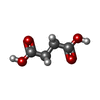 ChemComp-SIN: |
-Macromolecule #6: water
| Macromolecule | Name: water / type: ligand / ID: 6 / Number of copies: 1 / Formula: HOH |
|---|---|
| Molecular weight | Theoretical: 18.015 Da |
| Chemical component information | 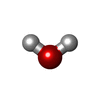 ChemComp-HOH: |
-Experimental details
-Structure determination
| Method | cryo EM |
|---|---|
 Processing Processing | single particle reconstruction |
| Aggregation state | particle |
- Sample preparation
Sample preparation
| Buffer | pH: 7.4 |
|---|---|
| Grid | Material: GOLD |
| Vitrification | Cryogen name: ETHANE |
- Electron microscopy
Electron microscopy
| Microscope | FEI TITAN KRIOS |
|---|---|
| Image recording | Film or detector model: GATAN K3 BIOQUANTUM (6k x 4k) / Average electron dose: 52.0 e/Å2 |
| Electron beam | Acceleration voltage: 300 kV / Electron source:  FIELD EMISSION GUN FIELD EMISSION GUN |
| Electron optics | Illumination mode: FLOOD BEAM / Imaging mode: BRIGHT FIELD / Nominal defocus max: 2.5 µm / Nominal defocus min: 1.2 µm |
| Experimental equipment |  Model: Titan Krios / Image courtesy: FEI Company |
- Image processing
Image processing
| Startup model | Type of model: PDB ENTRY PDB model - PDB ID: |
|---|---|
| Final reconstruction | Resolution.type: BY AUTHOR / Resolution: 2.97 Å / Resolution method: FSC 0.143 CUT-OFF / Number images used: 2043885 |
| Initial angle assignment | Type: NOT APPLICABLE |
| Final angle assignment | Type: NOT APPLICABLE |
 Movie
Movie Controller
Controller





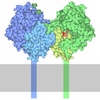

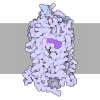
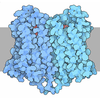




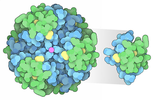
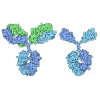




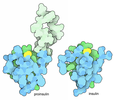
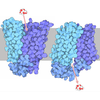
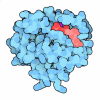

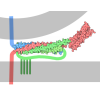
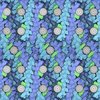

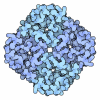
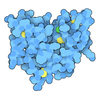


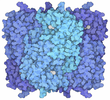
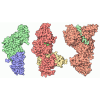
 Z (Sec.)
Z (Sec.) Y (Row.)
Y (Row.) X (Col.)
X (Col.)
